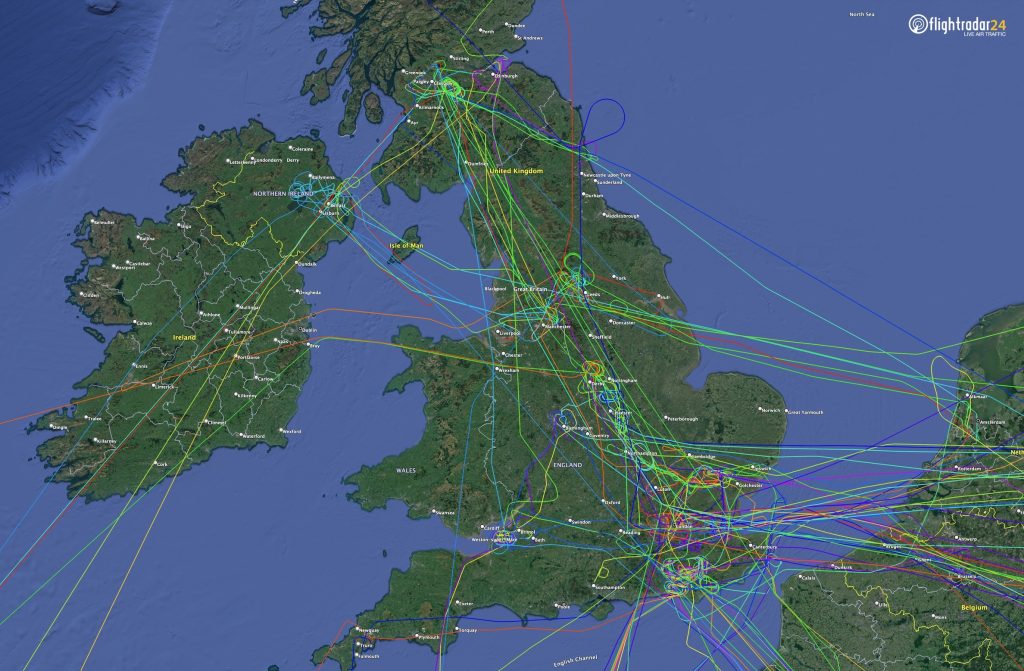Storm Isha brought widespread disruption to life across the United Kingdom and Ireland, with wind gusts frequently reaching speeds of over 100 miles per hour on January 21. Widespread, named storms have a significant impact on commercial aviation, and aircraft flying holding patterns, attempting approaches, and diverting to other airports were tracked by thousands of users on Flightradar24. ‘Go arounds’ (or aborted approaches to airports) were also common, with over 100 aircraft going around on January 21 according to UK air traffic service provider NATS). We used our data to highlight some of the most interesting stats for flights arriving to airports in the UK and Republic of Ireland.
Flight paths of diverting aircraft in the UK and Ireland. January 21, 2024. Flightradar24
A total of 83 aircraft inbound to the United Kingdom were diverted to other airports on January 21.
The longest passenger flight diversions
LH2518 – Lufthansa – Munich (MUC) to Dublin (DUB) – diverted back to Munich (MUC) – distance 748 nautical miles.
FR5911 – Ryanair – Lanzarote (ACE) to Dublin (DUB) – diverted to Bordeaux (BOD) – distance 560 nautical miles. This aircraft had a total flight time of just over 4 hours.
LS372 – Jet2 – Gran Canaria (LPA) to Belfast (BFS) – diverted to Paris (CDG) – distance 470 nautical miles. Total flight time was 5 hours and 20 minutes.
EW7460 – Eurowings – Hamburg (HAM) to London (LHR) – diverted back to Hamburg (HAM) – distance of 404 nautical miles. Total flight time was 3 hours and 33 minutes.
(Includes flights destined for the UK and Ireland. Based on the distance in nautical miles between the intended destination and the eventual diversion airport).
What about freighters?
The longest diversion encountered by a cargo aircraft was European Air Transport flight QY452. This aircraft diverted to Leipzig (LEJ) from East Midlands Airport (EMA) following a relatively short flight from Brussels (BRU). Several other DHL freighters also made the same diversion. This is likely due to DHL having a substantial base at Leipzig.
The most interesting diversion?
EI-EBD took its passengers on a magical mystery tour of the Irish Sea on January 21.
The award for ‘Most Interesting Diversion’ (or perhaps most frustrating) goes to Ryanair flight FR633. This flight from Copenhagen (CPH) to Dublin (DUB) initially diverted to Manchester (MAN). After a 4 hour wait, the aircraft made another attempt to reach Dublin, only to divert to Liverpool (LPL) after a 3-hour flight (just 40 miles from Manchester).
Which airlines saw the most diverted flights to the UK?
EasyJet saw a total of 17 diversions on January 21. 35% of these aircraft were destined for Bristol (BRS), diverting to airports including London Gatwick (LGW) and Paris Charles de Gaulle (CDG). EasyJet’s longest diversion was from London Gatwick to Lyon Airport (LYS), a distance of 388 nautical miles.
Whilst EasyJet’s flights to the UK were the most likely to be diverted, it was many of Ryanair’s flights that attracted attention on Flightradar24. A total of 11 Ryanair aircraft bound for UK destinations were diverted on January 21.
Wizzair’s aircraft were bound for London Gatwick (LGW) and London Luton (LTN). These were diverted as far afield as Brussels (BRU) and Eindhoven (EIN).
All 8 BA Cityflyer aircraft diverted to London Stansted (STN). This is typical for LCY-based aircraft.
How many flights were canceled?
Whilst we can’t be sure that any flight cancellations on January 21 were directly driven by Storm Isha, we can look at the overall trend of takeoff and landing cancellations at airports in the UK and Ireland.
Whilst Dublin Airport (DUB) and London Heathrow Airport (LHR) saw the highest numbers of cancellations, it’s important to appreciate the proportion of cancellations at these larger hubs was relatively low. Whilst cancellations at Heathrow accounted for around 9% of movements, cancellations at London City Airport (LCY) accounted for 62% of all operations thanks to the larger UK domestic route network operating from the airport.
The post Storm Isha – a look at the data appeared first on Flightradar24 Blog.
